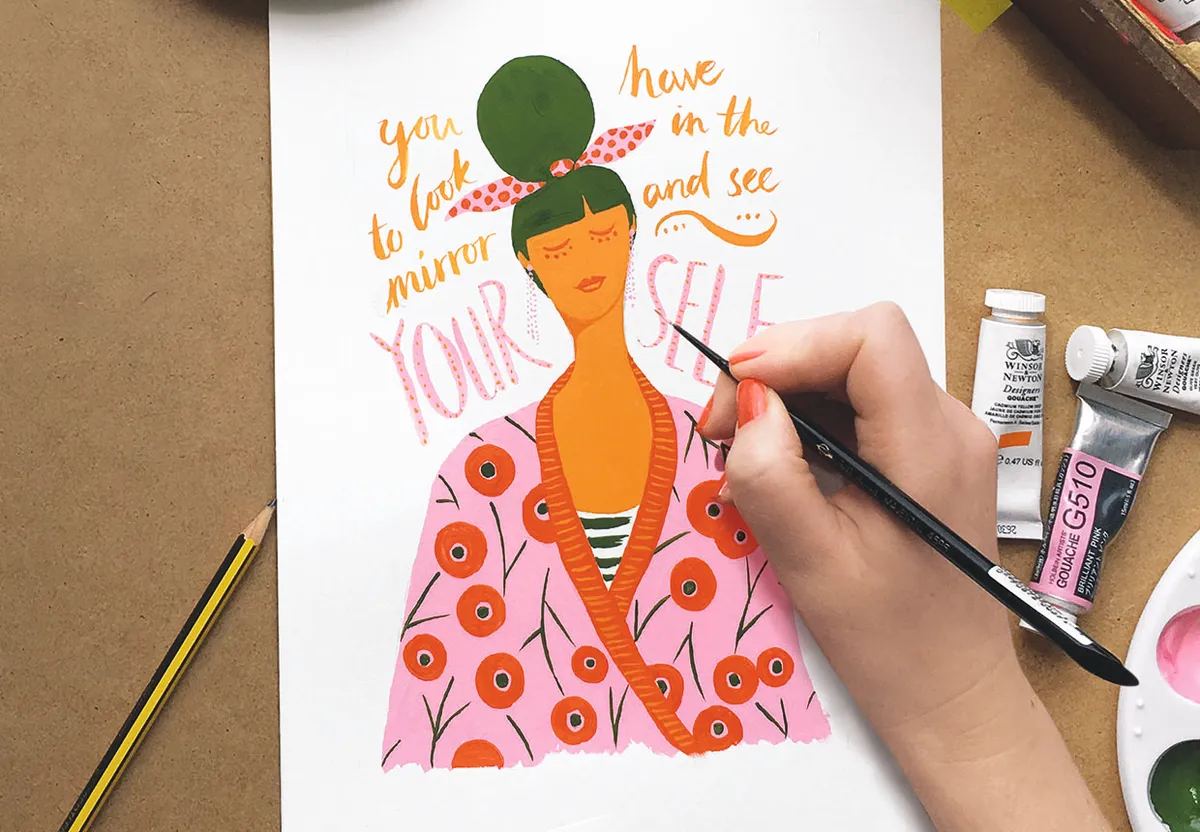Gouache (pronounced gwaash) has traditionally been less popular than other paint mediums such as acrylics and watercolours, but it has a lot to recommend it.
This medium is loved by artists and illustrators for its beautiful matte finish and dazzling colours.
If you’re new to painting and keen to crack on at home, it’s a good option for beginners and you can achieve impressive results in a very short period of time.
The materials you’ll need for gouache are relatively inexpensive (certainly in relation to oils), and it’s incredibly easy to get up and running.
Gouache has always been highly popular with illustrators and designers; if you like to create cards, prints or suchlike, it’s the absolute best.
Read on for our in-depth guide to gouache painting – we’ll talk you through the medium’s strengths, tricky points and all the materials you’ll need to get started.
We’ve also tackled some frequently asked questions to help you understand your paints and get the most out of them.
Your in-depth guide to painting with gouache
What is gouache paint?
The easiest way to describe gouache is as watercolour’s non-transparent cousin. Like watercolour, it uses gum arabic as a pigment binder.
But it has an opacity – especially when mixed with white – that lets you build it up in layers.
It’s a water-based paint, so it can be blended using water without the need for any additional mediums.
Is gouache hard for beginners?
Gouache is a very beginner-friendly medium, but it will take a little practice for you to get familiar with how it’s used.
It behaves very differently to watercolours or acrylics, so you’ll need to take the time to learn its quirks.
The biggest thing to bear in mind is that you’ll need to wait for your paints to dry if you want to use a different colour on top. If the paints are still wet, you risk the two colours mixing together.
What’s so special about gouache?
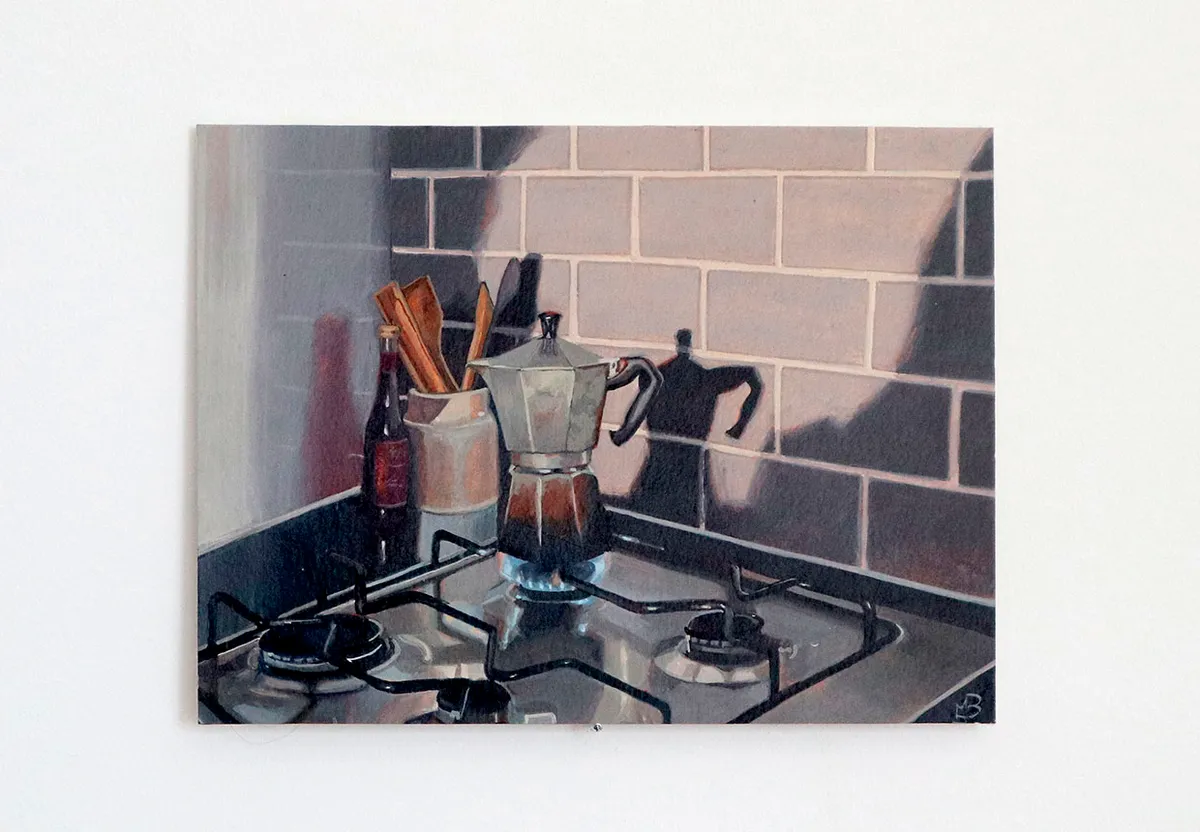
Gouache is rehydratable, which not only offers all sorts of benefits when it comes to painting, but means it’s easy to clean up.
You can wash dried gouache off a palette with no problem and if you spill it on a (non-porous) surface, a damp cloth will quickly remove it.
Another advantage of gouache is that it photographs beautifully – a major reason why it’s always been so popular with commercial artists who paint book jackets, magazine illustrations and other images for reproduction.
We’re not telling you to go that route... but your work will look mighty impressive on Instagram. Just saying.
Why is gouache unpopular?
Talk to artists of a certain generation about gouache, and they’ll likely roll their eyes and complain about the colour swatches they were forced to paint at art school.
While its natural flatness does make it suitable for humdrum tasks like this, far too often is gouache undervalued as a medium.
The fact that gouache is rehydratable makes it a difficult medium. Beginners often find that when they build up gouache in layers, they reactivate the paint beneath, which smudges and disturbs the painting.
You’ll probably have to grit your teeth through a few such mishaps. If it becomes a real problem, you can try acrylic gouache, which isn’t rehydratable.
Because it’s so pigment-rich, gouache is expensive. That’s why you’ll only find it available in small tubes of around 14ml (except for white, which mercifully you can get in larger 60ml tubes, and you’ll definitely use lots).
For this reason, you’ll always be restricted in size: gouache painting is a fundamentally small-scale activity.
What is the difference between gouache and watercolour?
Gouache paints and watercolours are both water-based, but have very different characteristics.
Gouache is opaque with a thicker consistency, while watercolours are translucent and fluid.
Most artists prefer one or the other, but the two can be used together. Watercolour artists will often keep a tube of white gouache to hand to add brilliant highlights to their work.
Discover more pros and cons of these two mediums in our gouache vs watercolour guide.
Is gouache paint better than acrylic?
Gouache and acrylic paints have some similarities: both can be applied thickly for an opaque finish.
However, that’s where the similarities end. Only gouache will dry with that flat, matte finish that’s so distinctive.
Acrylic paint is a very forgiving medium, as you can paint over any mistakes without it being too noticeable.
Once acrylic paint has dried, it’s permanently fixed. You can easily build layers of acrylic paint without disturbing the layers underneath.
Gouache can be reactivated with water meaning that base coats of paint can mix with upper coats.
Learn more about the differences between these two paints in Gathered’s gouache vs acrylic article.
How to use gouache
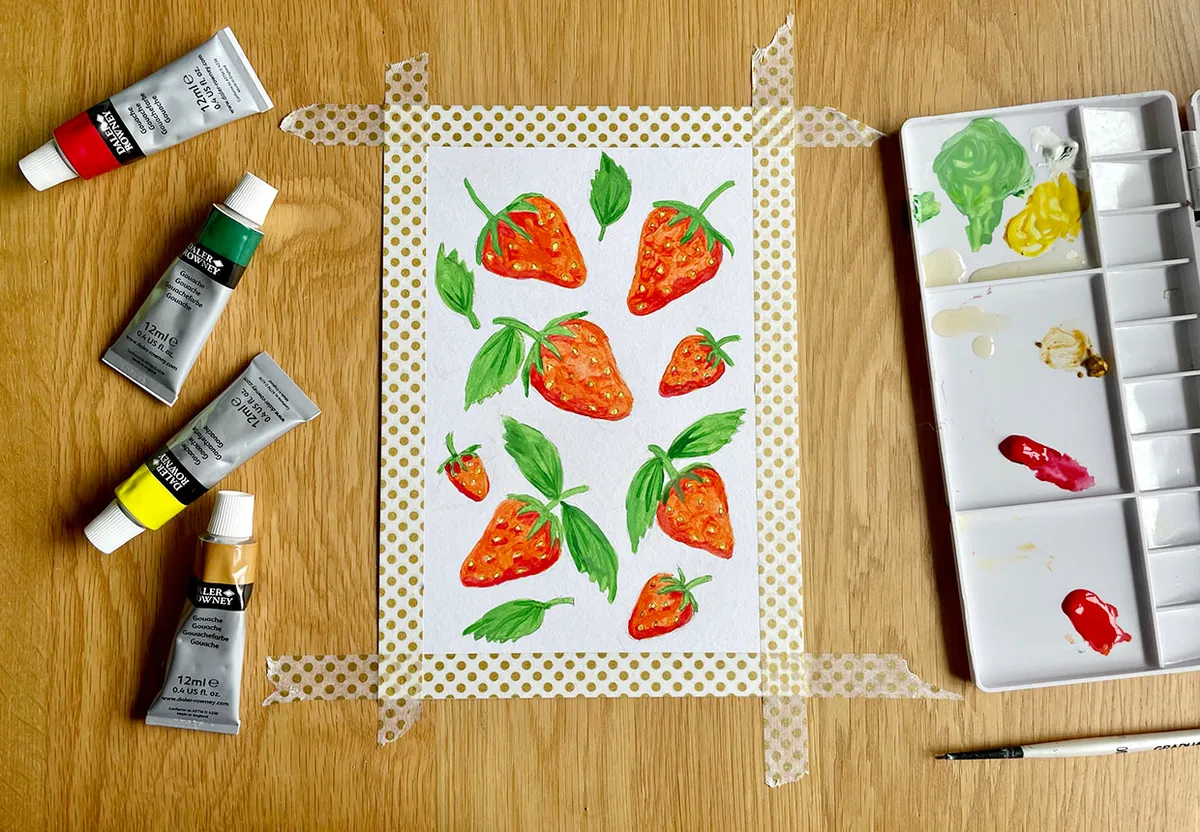
Like every medium, gouache has its own quirks that you’ll need to get used to if you want to get the most out of your paints.
For example, it’s important to know that gouache can change colour as it dries. Lighter colours can darken, while darker shades can turn out paler than expected.
Gouache is an incredibly versatile medium. You can use it in stains and translucent layers, much like watercolour. But you can also work opaquely by mixing white into your other colours – and this is where gouache really shines. It dries to a wonderfully flat, matte finish, which is why it’s so popular with graphic artists.
Then there’s a technique known as ‘tiling’, which you can see in the magnificent paintings of Norman Rockwell. This is where you paint your image in discrete shapes of colour, almost like a mosaic.
Then, once you’re done, you can take a damp brush and blend the edges of each of these tiles together by re-wetting the paint. This takes patience and lots of practice, but the results can be incredible.
Explore a variety of gouache painting techniques in our how to paint with gouache guide.
How to seal gouache
Paintings on paper often need a little post-production to both protect them and make them more presentable.
Since dried gouache can be re-wetted, you might want to seal your work with a fixative or varnish. After that, you could also mount it on a hard surface like a plywood panel, or put it behind glass in a frame.
Create beautiful watercolour artwork
Watercolour paints can be used to produce incredible paintings and there are always new techniques to explore!
Start experimenting with Gathered’s watercolour painting guide.
Essential gouache painting supplies
The basics
You’ll need a few basic essentials. An old rag is essential to wipe excess paint off your brush.
Some high-strength kitchen roll – the blue lint-free stuff – is useful too. Get a jar of water. An atomiser spray will also keep your paints wet for longer if you spritz them every ten minutes or so.
Gouache paint
As ever, we offer the same mantra to beginners: buy the best paints you can afford. Cheap gouache paints won’t deliver the same encouraging results.
Not only are they less pigment-rich, they’re often filled with white to give them extra opacity, giving them a milky quality you don’t necessarily want.
We’ve included a couple of recommendations below to help you get started, or for more options you take a look at our best gouache paint round-up.
M Graham Primary Colour gouache set
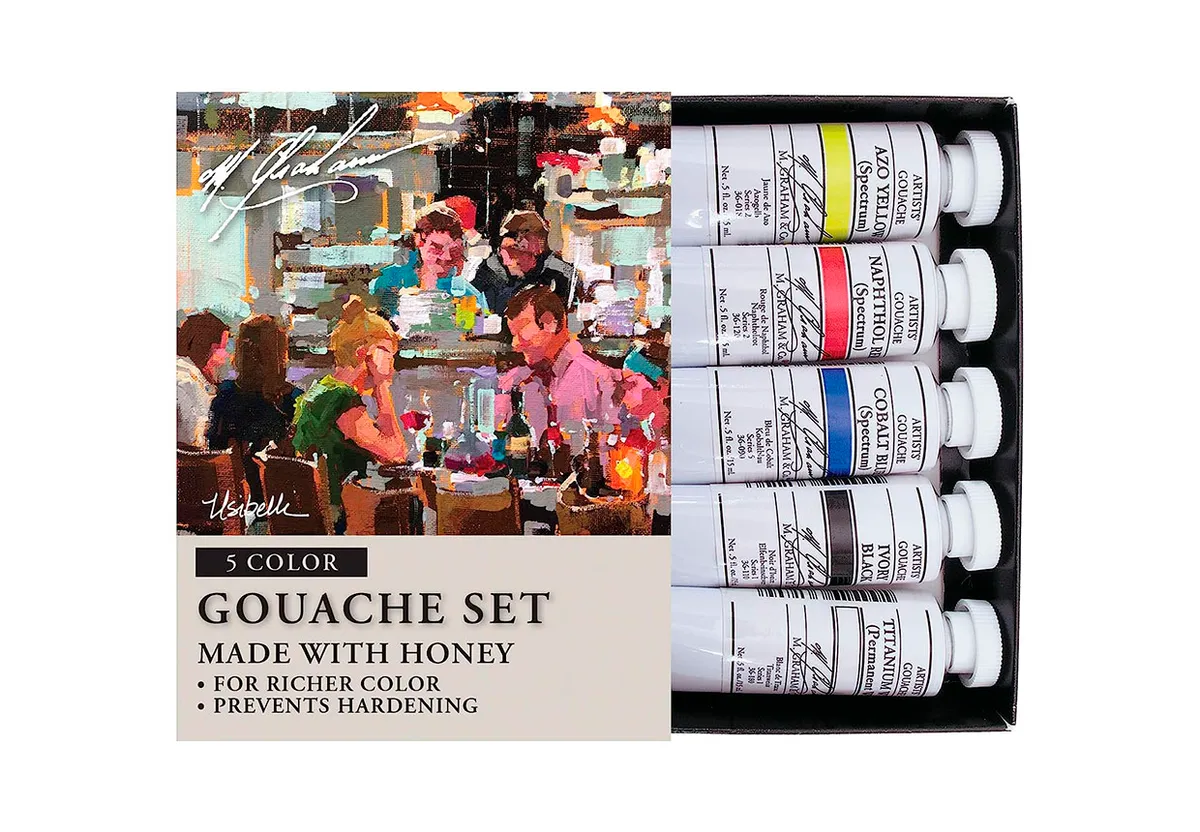
One of our favourite brands of gouache paints is M Graham.
These superb colours use honey rather than the usual gum arabic as a binder, which keeps them wet for longer. They’re costly, but worth every penny.
- Buy the M Graham Primary Colour Gouache set from Amazon
Himi gouache
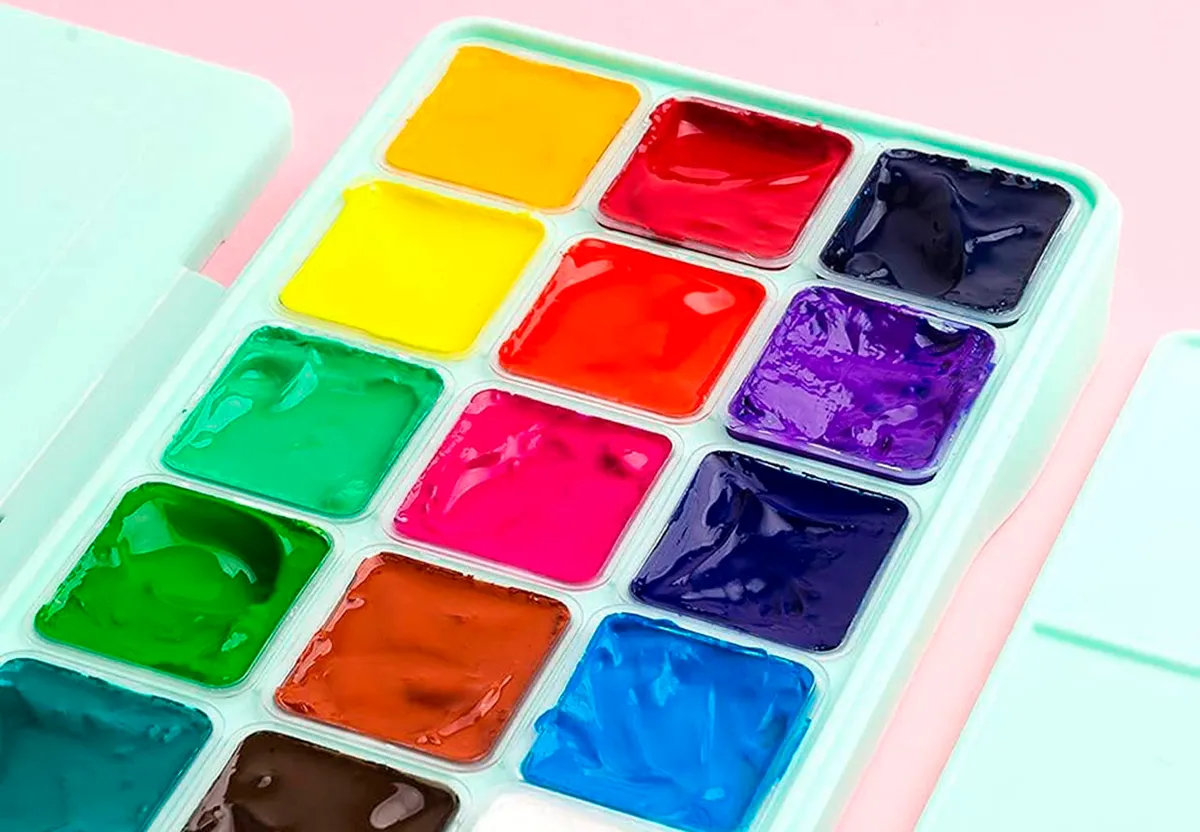
There’s also a relatively new addition to the gouache market, which has become very popular, very fast: Himi’s jelly gouaches, which are so-called because they come in plastic pots with peel-off lids.
Fun and inexpensive, they come in a cute plastic box and would make a lovely gift for any budding gouache artist. You can also buy single colour refills.
- Buy the Himi 18-Colour Jelly Gouache set from Amazon
A quick note on dry gouache: because gouache is rehydratable, you can reactivate colours with a wet brush, much like watercolour pans.
This is perfectly fine, and it’s certainly less wasteful than squeezing out fresh paint each time, when some will inevitably end up not being used. But for the money, gouache is like orange juice: best when freshly squeezed.
Brushes
Here’s the good news. While we urge you to buy good-quality paints, you can get away with cheaper synthetic brushes when painting with gouache, since it’s a paint that’s relatively gentle on brush hairs.
Something that we really, really appreciate about gouache is that if it dries in your brushes, they can be washed out easily. There are lots of great affordable options out there – take a look at our best brushes for gouache guide for Gathered’s recommendations.
ProArte Prolene Watercolour brush set
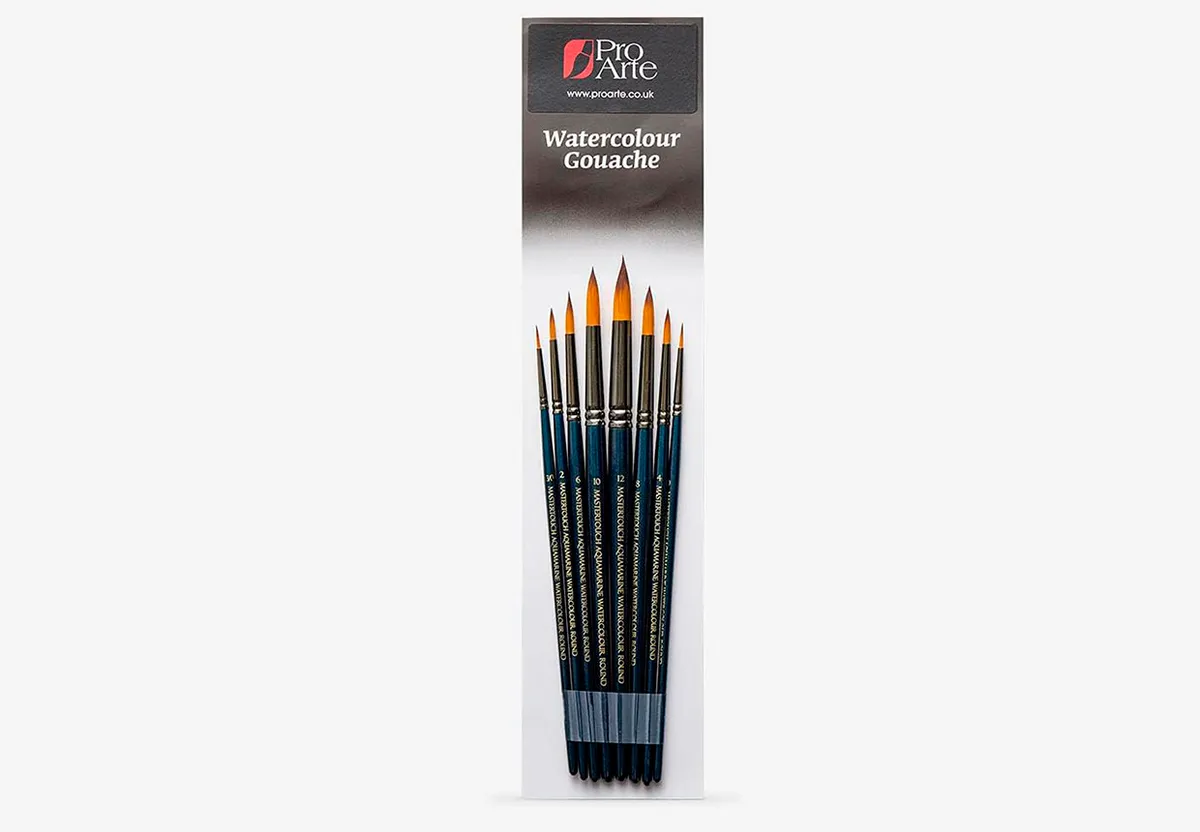
This set from ProArte is a solid option, offering you a comprehensive range of rounds and flats. These synthetic brushes have nice springy bristles and are unlikely to lose hair as you paint.
The brushes are suitable for both gouache and watercolours, but we’d recommend cleaning your brushes thoroughly after use if you like to use both mediums.
Buy the ProArte Prolene Watercolour set from Amazon
Palette
When choosing a paint palette for your gouache, we’d suggest looking for one with separate wells. Diluted gouache tends to bead on glass palettes and will run off flat traditional palettes.
However, there are a few other kinds of paint palettes you can try at home.
Enamel white serving tray
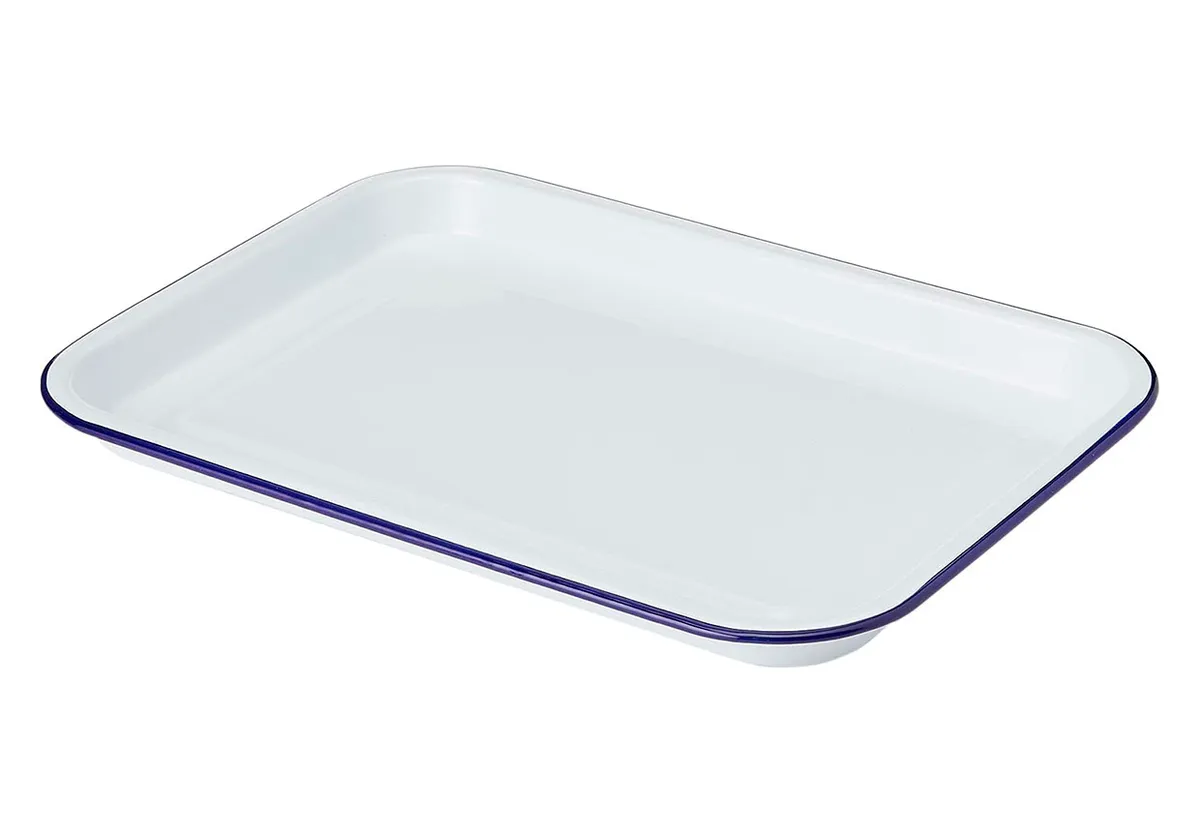
For home use, buy a white enamel tray, which is also known as a butcher’s tray. Trust us on this – it’s the best option out there.
This is a great makeshift alternative to a keep wet paint palette, which is designed to keep your paints moist and usable during longer painting sessions.
Fold a damp, saturated piece of paper towel into one corner of the tray, and squeeze out your colours here: the soggy paper will keep them wet for longer. At the end of your session, you can clean out the tray in the sink and it will look good as new.
- Buy the Enamel White Serving Tray from Amazon
Royal & Langnickel Small Folding Foldout palette
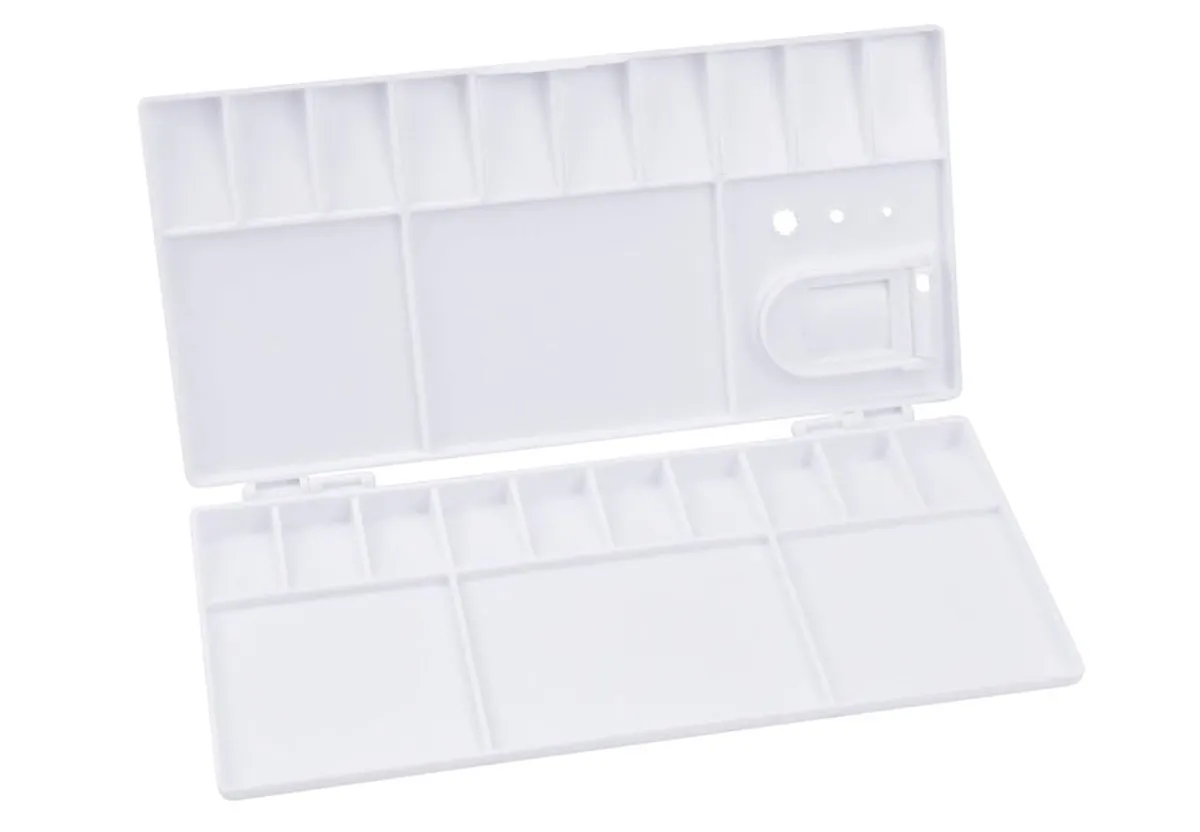
If you want to do some outdoor painting, consider a fold-out palette with a thumbhole, like this budget-friendly option from Royal & Langnickel. Small and discreet, you can stow it away in a backpack.
- Buy the Royal & Langnickel Small Folding Foldout palette from Amazon
Support
You can use gouache on canvas, but this isn’t where it shines. If the canvas is too flexible, the paint could easily crack. Gouache is best on paper or illustration board.
Whether it’s a sketchbook, sketchpad or loose sheets, the paper you choose should be 300gsm in weight, so it doesn’t crinkle.
You can choose between rough cold-pressed or smooth hot-pressed watercolour paper: our advice to newbies is to try both.
Strathmore Toned sketchpad
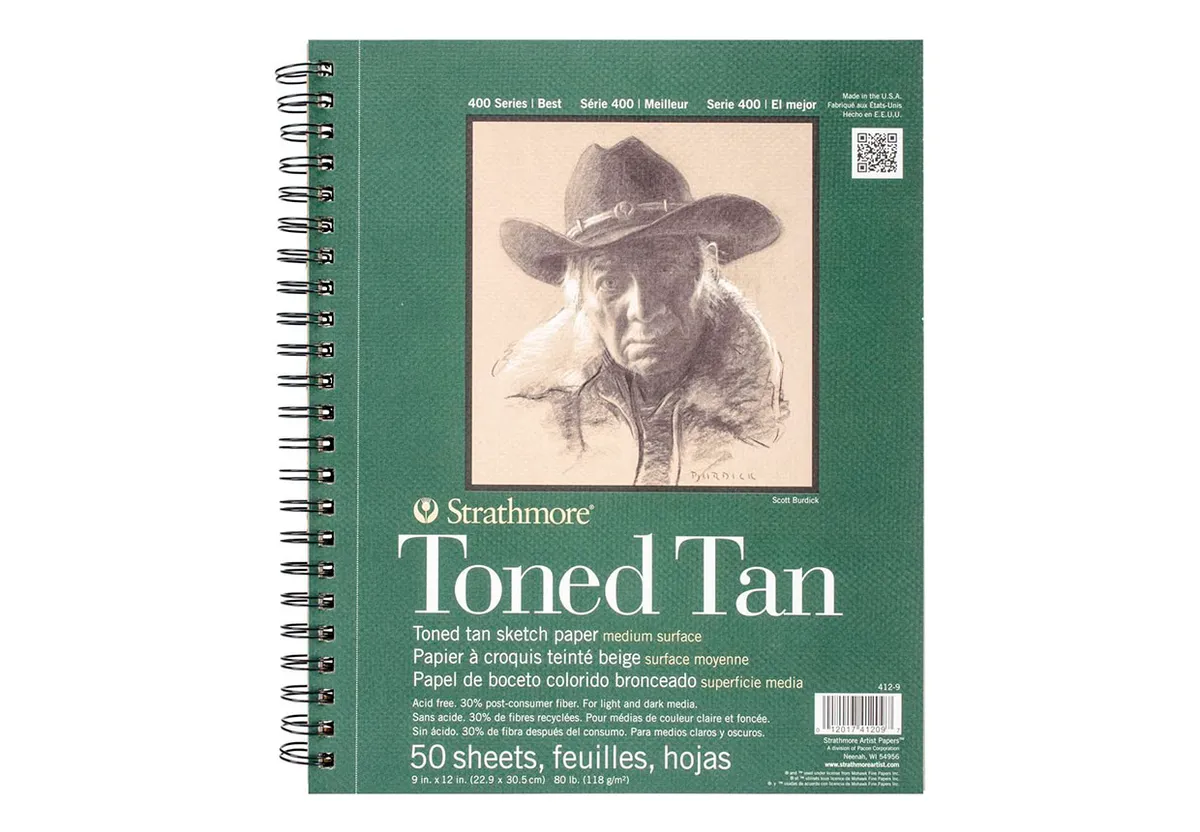
Toned paper makes for a nice alternative to white, which always looks a bit intimidating. Using a paper that’s already tinted takes away your fear of the blank page.
This Strathmore sketchpad is perfect for gouache. It comes in a soft tan shade and the paper is thick enough to handle gouache paint.
- Buy the Strathmore Toned Sketchpad from Amazon
Bockingford Hot Pressed watercolour block
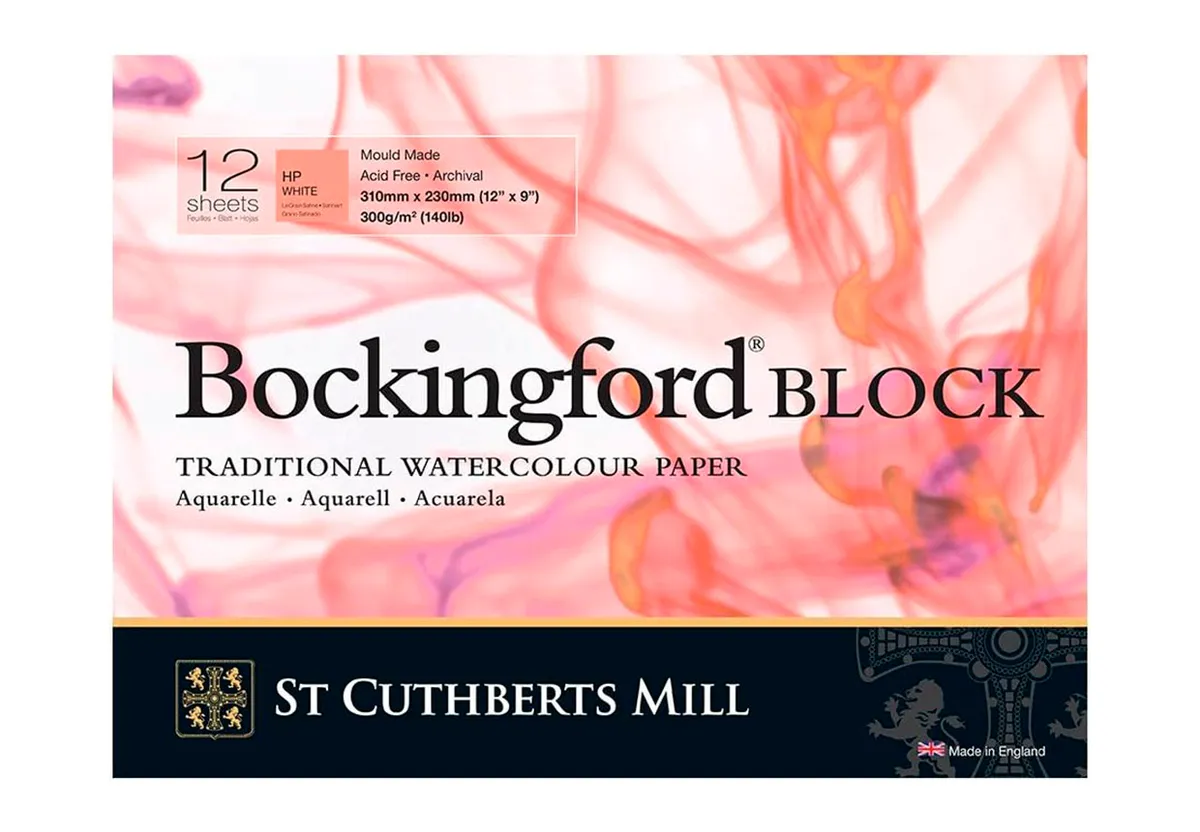
As we’ve previously mentioned, watercolour paper is also fantastic for gouache.
It’s able to absorb plenty of water without warping and has a beautifully smooth surface that suits gouache paints well. This block is more affordable than many paper pads of a similar standard, so we’d highly recommend it.
Buy the Bockingford Hot Pressed Watercolour Block from Amazon
Arches Cold Pressed watercolour pad
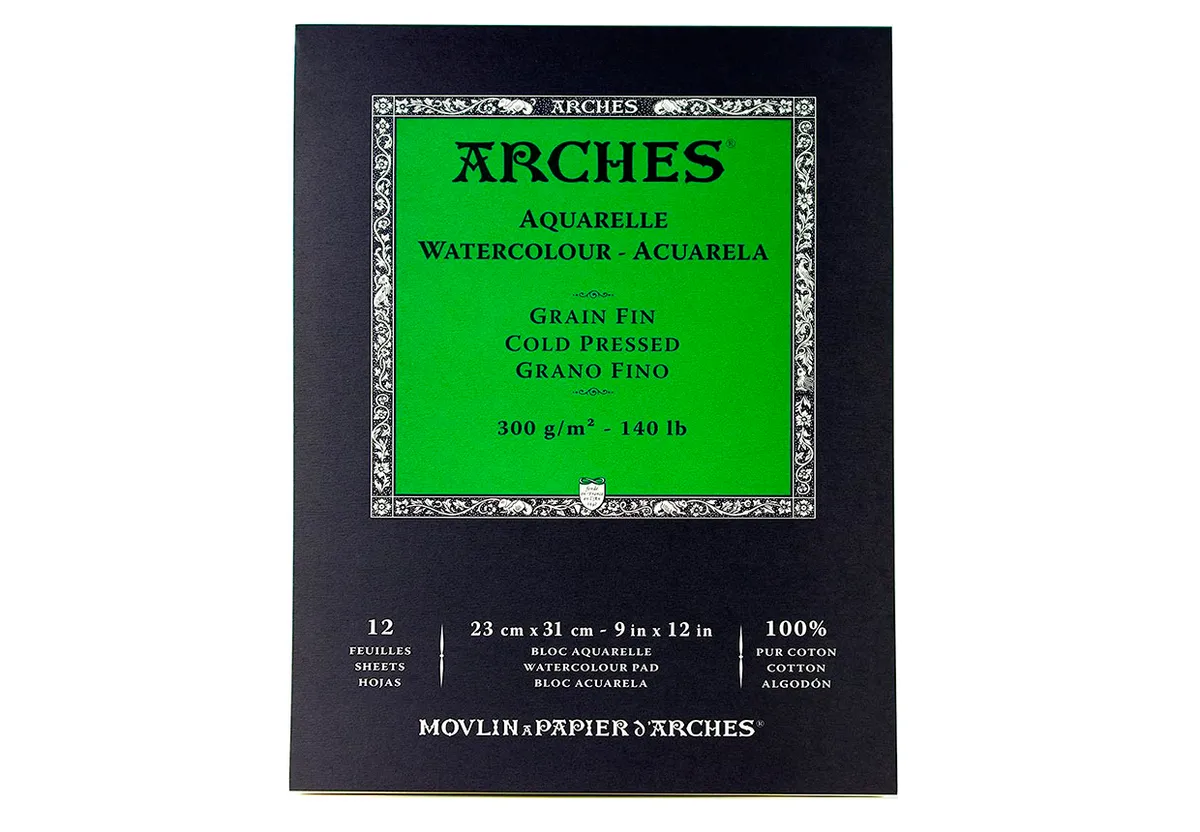
Prefer a rougher paper to work on? You’ll need to choose cold pressed paper, which has a more textured surface than hot pressed watercolour paper.
This rougher surface holds the paint well, as it gives it something to grip onto. Artists sometimes refer to this as ‘tooth’.
- Buy the Arches Cold Pressed watercolour pad from Amazon
Crescent illustration board
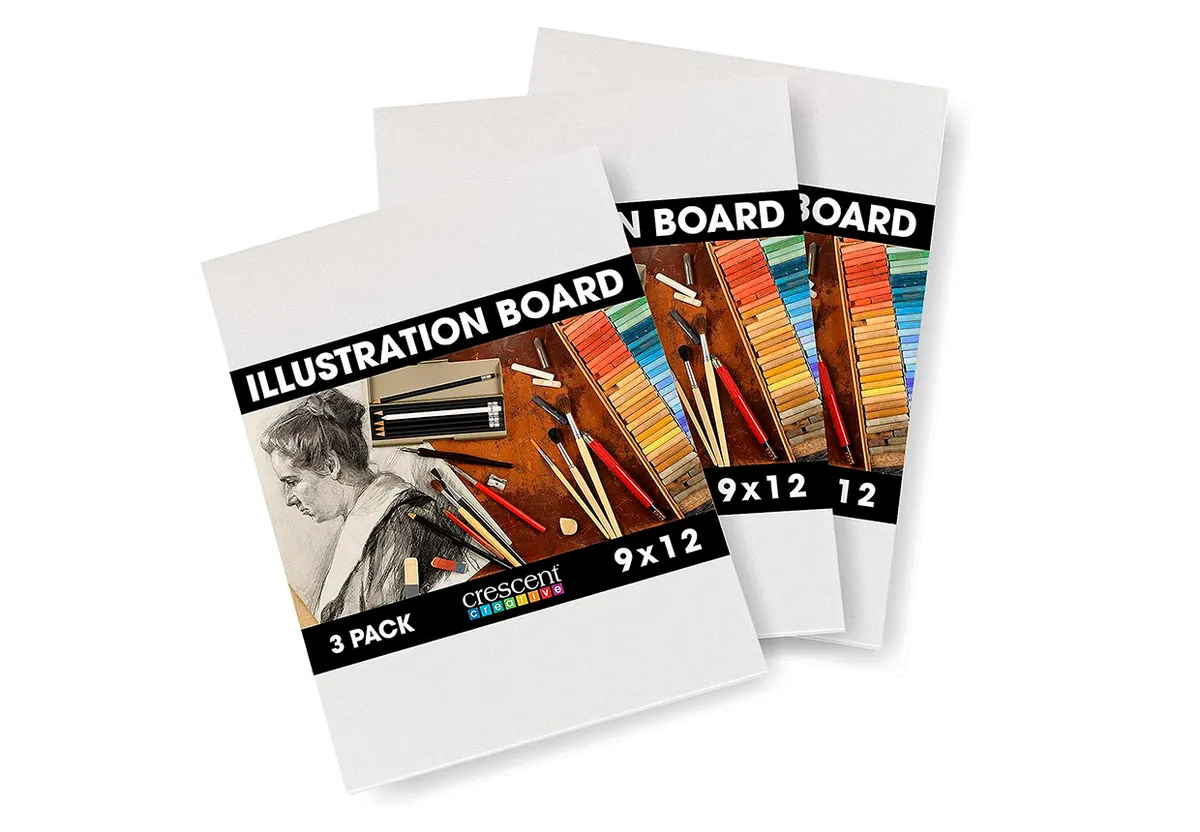
Illustration board comes in large sheets that you can cut to size - carefully, of course - with a craft knife. You’ll find that it can take thicker layers of gouache than paper.
Although it’s much thicker than paper, it can still sometimes curl inward or ‘potato chip’, but this is easily fixed with a little gentle correction.
- Buy the Crescent Illustration Board 3-Pack from Amazon
Anything else?
If you’ve got the above covered, you have everything you need for gouache painting. But you may also want to buy some Japanese washi tape, a low-stick tape to border the edges of your work.
It’ll make your paintings look much tidier, and peeling it off once you’ve finished is one of the most satisfying things you can imagine.
- Buy the 10-roll Japanese washi tape set from Amazon
Why gouache painting is popular with artists and illustrators of all abilities
Gouache’s matte texture and endless colour possibilities are loved by both artists and professional illustrators.
You don’t need a lot of skill to turn out impressive gouache paintings, but it’s worth taking the time to master this versatile medium.
Once you’ve chosen your materials and studied gouache painting techniques, you’ll be more than ready to dive into your next gouache project.
Begin your next project with our gouache painting ideas
Gouache can be used to cover endless themes, from dream-like paintings of your travels to colourful portraits.
Find an exciting selection of gouache painting ideas to try with Gathered.
